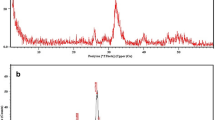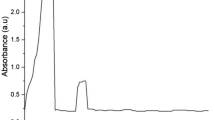Abstract
This study aims to illustrate the preparation of a new nanobiocomposite by incorporating copper oxide nanoparticles into cuttlebone matrix (CB/CuO NPs), and it was tested to define how effective it was to adsorb and remove arsenate from aqueous systems. CB is the bone tissue of cuttlefish with high porosity, permeability, and low cost. CuO NPs have been introduced as an effective arsenate adsorbent. Producing nanocomposite by introducing of CuO NPs in the structure of CB enhanced their stability and facilitated their separation from solution. Incorporation of CuO NPs in the structure of CB enhanced the adsorption capacity of CB. The adsorption data were fitted with both Langmuir and Freundlich isotherms, but Langmuir isotherm exhibited better matching rather than Freundlich isotherm. The maximum adsorption capacity (qmax) was calculated from Langmuir adsorption isotherm which was around 25.13 mg g−1. Kinetic data fitted well to the pseudo-second-order reaction model. The results indicate that the possible mechanism of arsenate adsorption on CB/CuO is through development of inner sphere complex. Simple preparation and abundant and good adsorption capacity in the presence of calcium ions indicate that the CB/CuO is suitable for removal of arsenate from contaminated drinking water.








Similar content being viewed by others
References
Alswat AA, Ahmad MB, Saleh TA (2016) Zeolite modified with copper oxide and iron oxide for lead and arsenic adsorption from aqueous solutions. J Water Supply Res Technol AQUA 65:465–479
Birchall JD, Thomas NL (1983) On the architecture and function of cuttlefish bone. J Mater Sci 18:2081–2086
Brion-Roby R, Gagnon J, Deschênes JS, Chabot B (2018) Investigation of fixed bed adsorption column operation parameters using a chitosan material for treatment of arsenate contaminated water. J Environ Chem Eng 6:505–511
Castaldia P, Silvetti M, Enzob S, Melisa P (2010) Study of sorption processes and FTIR analysis of arsenate sorbed onto red muds (a bauxite ore processing waste). J Hazard Mater 175:172–178
Culverwell E, Wimbush SC, Hall SR (2008) Biotemplated synthesis of an ordered macroporous superconductor with high critical current density using a cuttlebone template. Chem Commun:1055–1057
Dobaradaran S, Nabipour I, Keshtkar M, Ghasemi FF, Nazarialamdarloo T, Khalifeh F, Poorhosein M, Abtahi M, Saeedi R (2017) Self-purification of marine environments for heavy metals: a study on removal of lead(II) and copper(II) by cuttlebone. Water Sci Technol 75:474–481
Elwakeel KZ, Guibal E (2015) Arsenic(V) sorption using chitosan/Cu(OH)2 and chitosan/CuO composite sorbents. Carbohydr Polym 134:190–204
Ghorbanzadeh N, Jung W, Halajnia A, Lakzian A, Kabra AN, Jeon BH (2015) Removal of arsenate and arsenite from aqueous solution by adsorption on clay minerals. Geosyst Eng 18:302–311
Gogoi P, Thakur AJ, Devi RR, Das B, Maji TK (2017) Adsorption of As(V) from contaminated water over chitosan coated magnetite nanoparticle: equilibrium and kinetics study. Environ Nanotechnol Monit Manag 8:297–305
Goswami A, Raul PK, Purkait MK (2012) Arsenic adsorption using copper (II) oxide nanoparticles. Chem Eng Res Des 90:1387–1396
Gupta A, Chauhan VS, Sankararamakrishnan N (2009) Preparation and evaluation of iron–chitosan composites for removal of As(III) and As(V) from arsenic contaminated real life groundwater. Water Res 43:3862–3870
Jang JK, Lee OS, Kang TJ, Lim SC (2013) Wound healing effect of cuttlebone extract in burn injury of rat. Food Sci Biotechnol 22:99–105
Jia X, Qian W, Wu D, Wei D, Xu G, Liu X (2009) Cuttlebone-derived organic matrix as a scaffold for assembly of silver nanoparticles and application of the composite films in surface-enhanced Raman scattering. Colloids Surf B: Biointerfaces 68:231–237
Korngold E, Belayev N, Aronov L (2001) Removal of arsenic from drinking water by anion exchangers. Desalination 141:81–84
Lalhmunsiama L, Nautiyal BP, Tiwari D, Choi SI, Kong S-H, Lee S-M (2016) Silane grafted chitosan for the efficient remediation of aquatic environment contaminated with arsenic(V). J Colloid Interface Sci 467:203–212
Li X, Zhao Y, Bing Y, Li Y, Gan N, Guo Z, Peng Z, Zhu Y (2013) Biotemplated syntheses of macroporous materials for bone tissue engineering scaffolds and experiments in vitro and vivo. ACS Appl Mater Interfaces 5:5557–5562
Liu G, Talley JW, Na C, Larson SL, Wolfe LG (2010) Copper doping improves hydroxyapatite sorption for arsenate in simulated groundwaters. Environ Sci Technol 44:1366–1372
Malwal D, Gopinath P (2016) Rapid and efficient removal of arsenic from water using electrospun CuO-ZnO composite nanofibers. RSC Adv 6:115021–115028
Martinson CA, Reddy KJ (2009) Adsorption of arsenic(III) and arsenic(V) by cupric oxide nanoparticles. J Colloid Interface Sci 336:406–411
McDonald KJ, Reddy KJ, Singh N, Singh RP, Mukherjee S (2015a) Removal of arsenic from groundwater in West Bengal, India using CuO nanoparticle adsorbent. Environ Earth Sci 73:3593–3601
McDonald KJ, Reynolds B, Reddy KJ (2015b) Intrinsic properties of cupric oxide nanoparticles enable effective filtration of arsenic from water. Sci Rep 5
Mehrizad A (2017) Adsorption studies of some phenol derivatives onto Ag-cuttlebone nanobiocomposite: modeling of process by response surface methodology. Res Chem Intermed 43:4295–4310
Min L-L, Yuan Z-H, Zhong L-B, Liu Q, Wu R-X, Zheng Y-M (2015) Preparation of chitosan based electrospun nanofiber membrane and its adsorptive removal of arsenate from aqueous solution. Chem Eng J 267:132–141
Nasir AM, Goh PS, Ismail AF (2019) Highly adsorptive polysulfone/hydrous iron-nickel-manganese (PSF/HINM) nanocomposite hollow fiber membrane for synergistic arsenic removal. Sep Purif Technol:162–175
Peng B, Song T, Wang T, Chai L, Yang W, Li X, Li C, Wang H (2016) Facile synthesis of Fe3O4@Cu(OH)2 composites and their arsenic adsorption application. Chem Eng J 299:15–22
Pessoa-Lopes M, Crespo JG, Velizarov S (2016) Arsenate removal from sulphate-containing water streams by an ion-exchange membrane process. Sep Purif Technol 166:125–134
Pillewan P, Mukherjee S, Roychowdhury T, Das S, Bansiwal A, Rayalu S (2011) Removal of As(III) and As(V) from water by copper oxide incorporated mesoporous alumina. J Hazard Mater 186:367–375
Poompradub S, Ikeda Y, Kokubo Y, Shiono T (2008) Cuttlebone as reinforcing filler for natural rubber. Eur Polym J 44:4157–4164
Prabhu SM, Imamura S, Sasaki K (2019) Mono-, di-, and tricarboxylic acid facilitated lanthanum-based organic frameworks: insights into the structural stability and mechanistic approach for superior adsorption of arsenate from water. ACS Sustain Chem Eng 7:6917–6928
Pramanik K, Sarkar P, Bhattacharyay D (2019) 3-Mercapto-propanoic acid modified cellulose filter paper for quick removal of arsenate from drinking water. Int J Biol Macromol 122:185–194
Ramos Guivar JA, Bustamante DA, Gonzalez JC, Sanches EA, Morales MA, Raez JM, López-Muñoz MJ, Arencibia A (2018) Adsorption of arsenite and arsenate on binary and ternary magnetic nanocomposites with high iron oxide content. Appl Surf Sci 454:87–100
Sandoval MA, Fuentes R, Nava JL, Coreño O, Li Y, Hernández JH (2019) Simultaneous removal of fluoride and arsenic from groundwater by electrocoagulation using a filter-press flow reactor with a three-cell stack. Sep Purif Technol 208:208–216
Senn AC, Hug SJ, Kaegi R, Hering JG, Voegelin A (2018) Arsenate co-precipitation with Fe(II) oxidation products and retention or release during precipitate aging. Water Res 131:334–345
Shahid MK, Phearom S, Choi YG (2018) Synthesis of magnetite from raw mill scale and its application for arsenate adsorption from contaminated water. Chemosphere 203:90–95
Shehzad K, Ahmad M, Xie C, Zhan D, Wang W, Li Z, Xu W, Liu J (2019) Mesoporous zirconia nanostructures (MZN) for adsorption of As(III) and As(V) from aqueous solutions. J Hazard Mater:75–84
Sheikhmohammadi A, Dahaghin Z, Mohseni SM, Sarkhosh M, Azarpira H, Atafar Z, Abtahi M, Rezaei S, Sardar M, Masoudi H, Faraji M, Nazari S, Pouya RH, Almasian M (2018) The synthesis and application of the SiO2@Fe3O4@MBT nanocomposite as a new magnetic sorbent for the adsorption of arsenate from aqueous solutions: modeling, optimization, and adsorption studies. J Mol Liq 255:313–323
Singh P, Chauhan K, Priya V, Singhal RK (2016a) A greener approach for impressive removal of As(III)/As(V) from an ultra-low concentration using a highly efficient chitosan thiomer as a new adsorbent. RSC Adv 6:64946–64961
Singh DK, Mohan S, Kumar V, Hasan SH (2016b) Kinetic, isotherm and thermodynamic studies of adsorption behaviour of CNT/CuO nanocomposite for the removal of As(III) and As(V) from water. RSC Adv 6:1218–1230
Veličković Z, Vuković GD, Marinković AD, Moldovan MS, Perić-Grujić AA, Uskoković PS, Ristić MT (2012) Adsorption of arsenate on iron(III) oxide coated ethylenediamine functionalized multiwall carbon nanotubes. Chem Eng J 181-182:174–181
Vera R, Zhang Y, Fontàs C, Almeida MIGS, Anticó E, Cattrall RW, Kolev SD (2019) Automatic determination of arsenate in drinking water by flow analysis with dual membrane-based separation. Food Chem 283:232–238
Wang C, Liu X, Chen JP, Li K (2015) Superior removal of arsenic from water with zirconium metal-organic framework UiO-66. Sci Report 5:16613
Wang Z, Hu W, Kang Z, He X, Cai Z, Deng B (2019) Arsenate adsorption on iron-impregnated ordered mesoporous carbon: Fast kinetics and mass transfer evaluation. Chem Eng J 357:463–472
Xu G, Li H, Ma X, Jia X, Dong J, Qian W (2009) A cuttlebone-derived matrix substrate for hydrogen peroxide/glucose detection. Biosens Bioelectron 25:362–367
Yang L, Wu S, Chen JP (2007) Modification of activated carbon by polyaniline for enhanced adsorption of aqueous arsenate. Ind Eng Chem Res 46:2133–2140
Zhang W, Zhang G, Liu C, Li J, Zheng T, Ma J, Wang L, Jiang J, Zhai X (2018) Enhanced removal of arsenite and arsenate by a multifunctional Fe-Ti-Mn composite oxide: Photooxidation, oxidation and adsorption. Water Res 147:264–275
Acknowledgments
The authors wish to express their gratitude to Shiraz University Research Council, for the financial support of this work. This project was partly supported by Iran National Science Foundation (Research Chair Award N. 95/INSF/44913).
Author information
Authors and Affiliations
Corresponding author
Ethics declarations
Conflict of interest
The authors declare that they have no conflict of interest.
Additional information
Responsible editor: Tito Roberto Cadaval Jr
Publisher’s note
Springer Nature remains neutral with regard to jurisdictional claims in published maps and institutional affiliations.
Rights and permissions
About this article
Cite this article
Momeni, S., Ahmadi, R. & Nabipour, I. Arsenate removal from aqueous solutions by cuttlebone/copper oxide nanobiocomposite. Environ Sci Pollut Res 26, 37162–37173 (2019). https://doi.org/10.1007/s11356-019-06679-6
Received:
Accepted:
Published:
Issue Date:
DOI: https://doi.org/10.1007/s11356-019-06679-6




